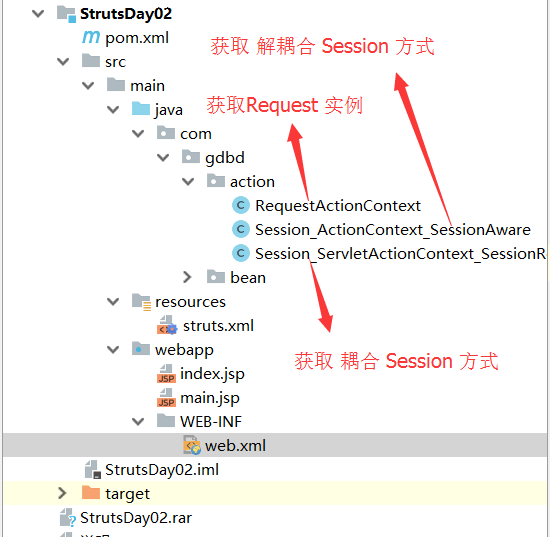目录结构:

POM:
<properties>
<project.build.sourceEncoding>UTF-8</project.build.sourceEncoding>
<maven.compiler.source>1.7</maven.compiler.source>
<maven.compiler.target>1.7</maven.compiler.target>
</properties>
<dependencies>
<!--测试JAR-->
<dependency>
<groupId>junit</groupId>
<artifactId>junit</artifactId>
<version>4.11</version>
</dependency>
<!--javaee.jar包是支持javaweb编程的基础jar包,跟javase编程需要jre一样!-->
<dependency>
<groupId>javaee</groupId>
<artifactId>javaee-api</artifactId>
<version>5</version>
</dependency>
<!--Struts2-core核心-->
<dependency>
<groupId>org.apache.struts</groupId>
<artifactId>struts2-core</artifactId>
<version>2.3.4.1</version>
</dependency>
<!--xwork 的核心包,最主要的功能是 支持了过滤器(interceptor)。-->
<dependency>
<groupId>org.apache.struts.xwork</groupId>
<artifactId>xwork-core</artifactId>
<version>2.3.4.1</version>
</dependency>
</dependencies>
RequestActionContext:
package com.gdbd.action;
import com.opensymphony.xwork2.Action;
import com.opensymphony.xwork2.ActionContext;
import org.apache.struts2.ServletActionContext;
import org.apache.struts2.interceptor.ServletRequestAware;
import javax.servlet.http.HttpServletRequest;
import java.util.Map;
/**
* 获取 request 三种方式
* 1):ActionContext.getContext().get("request")
* 2):ServletActionContext.getRequest()
* 3):实现 ServletRequestAware 接口
* 推荐使用 实现 ServletRequestAware 接口方式通过IOC机制注入request对象
*
* @author asus
*/
public class RequestActionContext implements Action, ServletRequestAware {
private HttpServletRequest request;
/***
* 默认执行的方法
* @return
* @throws Exception
*/
@Override
public String execute() throws Exception {
return "success";
}
public String getRequest1() {
Map request = (Map) ActionContext.getContext().get("request");
request.put("message", "获取 request方式一:ActionContext.getContext().get("request");");
return "success";
}
public String getRequest2() {
HttpServletRequest request = ServletActionContext.getRequest();
request.setAttribute("message", "获取 request方式二:ServletActionContext.getRequest();");
return "success";
}
public String getRequest3() {
request.setAttribute("message", "获取 request方式三:实现 ServletRequestAware 接口;");
return "success";
}
@Override
public void setServletRequest(HttpServletRequest httpServletRequest) {
this.request = httpServletRequest;
}
}
Session_ActionContext_SessionAware:
package com.gdbd.action;
import com.opensymphony.xwork2.Action;
import com.opensymphony.xwork2.ActionContext;
import org.apache.struts2.interceptor.SessionAware;
import java.util.Map;
/**
* 获取 Session 两种解耦方式
* 1):ActionContext.getContext().getSession()
* 2):实现 SessionAway 接口
*
* @author asus
*/
public class Session_ActionContext_SessionAware implements Action,SessionAware {
private Map<String, Object> map;
/***
* 默认执行的方法
* @return
* @throws Exception
*/
@Override
public String execute() throws Exception {
return "success";
}
public String getSession() {
//解耦方式实现
Map<String, Object> session = ActionContext.getContext().getSession();
session.put("message", "解耦方式一:ActionContext.getContext().getSession();");
return "success";
}
public String getSession1() {
map.put("message", "解耦方式二:实现 SessionAway 接口;");
return "success";
}
@Override
public void setSession(Map<String, Object> map) {
this.map = map;
}
}
Session_ServletActionContext_SessionRequestAware:
package com.gdbd.action;
import com.opensymphony.xwork2.Action;
import com.opensymphony.xwork2.ActionContext;
import org.apache.struts2.ServletActionContext;
import org.apache.struts2.interceptor.ServletRequestAware;
import org.apache.struts2.interceptor.SessionAware;
import javax.servlet.http.HttpServletRequest;
import javax.servlet.http.HttpSession;
import java.util.Map;
/**
* 获取 Session 两种耦合方式
* 1):ActionContext.getContext().getSession()
* 2):实现 SessionAway 接口
*
* @author asus
*/
public class Session_ServletActionContext_SessionRequestAware implements Action,ServletRequestAware {
private HttpServletRequest request;
/***
* 默认执行的方法
* @return
* @throws Exception
*/
@Override
public String execute() throws Exception {
return "success";
}
/***
* 耦合方式实现1
* @return
*/
public String getSession1() {
HttpSession session = ServletActionContext.getRequest().getSession();
session.setAttribute("message", "ServletActionContext.getRequest().getSession()");
return "success";
}
/***
* 耦合方式实现2
* @return
*/
public String getSession2() {
HttpSession session = request.getSession();
session.setAttribute("message", "耦合方式二:实现ServletRequestAware接口;");
return "success";
}
@Override
public void setServletRequest(HttpServletRequest httpServletRequest) {
this.request=httpServletRequest;
}
}
struts.xml:
<?xml version="1.0" encoding="UTF-8" ?>
<!DOCTYPE struts PUBLIC "-//Apache Software Foundation//DTD Struts Configuration 2.0//EN"
"http://struts.apache.org/dtds/struts-2.0.dtd">
<struts>
<package name="default" namespace="/" extends="struts-default">
<!--获取Session 解耦两种方式-->
<action name="Session" class="com.gdbd.action.Session_ActionContext_SessionAware">
<result name="success">/main.jsp</result>
</action>
<!--获取Session 耦合两种方式-->
<action name="OSession" class="com.gdbd.action.Session_ServletActionContext_SessionRequestAware">
<result name="success">/main.jsp</result>
</action>
<!--获取request 三种方式-->
<action name="Request" class="com.gdbd.action.RequestActionContext">
<result name="success">/main.jsp</result>
</action>
</package>
</struts>
index.jsp:
<%@ taglib prefix="s" uri="/struts-tags" %>
<%--
Created by IntelliJ IDEA.
User: asus
Date: 2018/11/13
Time: 12:11
To change this template use File | Settings | File Templates.
--%>
<%@ page contentType="text/html;charset=UTF-8" language="java" isELIgnored="false" %>
<html>
<head>
<title>第一天第一次测试</title>
</head>
<body>
<fieldset>
<legend>获取Session 解耦方式一</legend>
<a href="/Session!getSession">ActionContext.getContext().getSession();</a>
</fieldset>
<br/>
<fieldset>
<legend>获取Session 解耦方式二</legend>
<a href="/Session!getSession1">实现 SessionAway 接口;</a>
</fieldset>
<br/><br/>
<fieldset>
<legend>获取Session 耦合方式一</legend>
<a href="/OSession!getSession1">ServletActionContext.getRequest().getSession();</a>
</fieldset>
<br/>
<fieldset>
<legend>获取Session 耦合方式二</legend>
<a href="/OSession!getSession2">实现ServletRequestAware 接口;</a>
</fieldset>
<br/><br/>
<hr/>
<br/><br/>
<fieldset>
<legend>获取Request 三种方式</legend>
<a href="/Request!getRequest1">获取 request方式一:ActionContext.getContext().get("request");</a>
<a href="/Request!getRequest2">获取 request方式二:ServletActionContext.getRequest();</a>
<a href="/Request!getRequest3">获取 request方式三:实现 ServletRequestAware 接口;</a>
<p style="color: red">
推荐使用 实现 ServletRequestAware 接口方式通过IOC机制注入request对象
<br/>
该方法必须要实现,而且该方法是自动被调用这个方法在被调用的过程中,会将创建好的request对象通过参数的方式传递给你,你可以用来赋给你本类中的变量,然后request就可以使用了
<br/>
注意:
<br/>
setServletRequest()方法一定会再execute()方法被调用前执行在jsp页面中获取其中的值
<br/>
在上面的代码中,在Action实现了一个ServletRequestAware接口,并且实现了setServletRequest方法。
<br/>
如果一个动作类实现了ServletRequestAware接口,Struts2在调用execute方法之前,就会先调用setServletRequest方法,并将Request参数传入这个方法。
<br/>
如果想获得HttpServletResponse、HttpSession和Cookie等对象,动作类可以分别实现ServletResponseAware、SessionAware和CookiesAware等接口。这些接口都在org.apache.struts2.interceptor包中。
</p>
</fieldset>
</body>
</html>
main.jsp:
<%@ taglib prefix="s" uri="/struts-tags" %>
<%--
Created by IntelliJ IDEA.
User: asus
Date: 2018/11/13
Time: 12:11
To change this template use File | Settings | File Templates.
--%>
<%@ page contentType="text/html;charset=UTF-8" language="java" isELIgnored="false" %>
<html>
<head>
<title>第一天第一次测试</title>
</head>
<body>
<h1>${message}</h1>
</body>
</html>
web.xml:
<!DOCTYPE web-app PUBLIC
"-//Sun Microsystems, Inc.//DTD Web Application 2.3//EN"
"http://java.sun.com/dtd/web-app_2_3.dtd" >
<web-app>
<display-name>Archetype Created Web Application</display-name>
<!--核心过滤器-->
<filter>
<filter-name>struts2</filter-name>
<filter-class>org.apache.struts2.dispatcher.ng.filter.StrutsPrepareAndExecuteFilter</filter-class>
</filter>
<filter-mapping>
<filter-name>struts2</filter-name>
<url-pattern>/*</url-pattern>
</filter-mapping>
</web-app>
源码下载:https://github.com/MlqBeginner/BlogGardenWarehouse/blob/master/StrutsDay02.rar
--欢迎评论:若有不足之处多多指教
Face your past without regret. Handle your present with confidence.Prepare for future without fear. keep the faith and drop the fear.
面对过去无怨无悔,把握现在充满信心,备战未来无所畏惧。保持信念,克服恐惧!一点一滴的积累,一点一滴的沉淀,学技术需要不断的积淀!